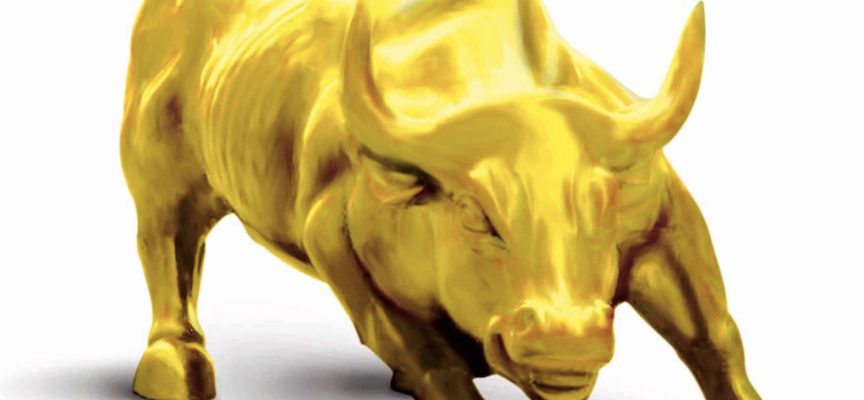As we kickoff trading in the month of November, today a legend in the business sent King World News a powerful piece stating that a fiscal hurricane will send the price of gold soaring nearly $1,000.
Gold’s Catalyst
By John Ing, Maison Placements
November 1 (King World News) – Mr. Trump will replace Chairperson Yellen next February. Good. The job is responsible for safeguarding the US economy and the Fed is a source of global financial stability or recently instability. Yellen viewed inflation a bit of a “mystery” citing the Fed’s understanding of inflation as “imperfect”. She said, “We recognize that something more persistent may be responsible for the current undershooting”. To us, there is no mystery. Decades of debasing their currency, has made money too cheap helping to inflate the biggest asset bubble in history from stocks to bonds to real estate to bitcoins causing economic, political and social havoc and, by extension, distorting the price of all assets and of course, risk.
Inflation Time Bomb
Yet, there is inflation, the Fed is playing semantics and sitting on an inflation time bomb. Already there are early signs of a return to “cost-push” inflation. Metal commodities have turned up, reflecting China’s insatiable appetite for resources. Open interest in futures from crude to wheat have reached record levels. Oil is flirting with $55 a barrel, a two-year high. As for food inflation? Florida was hard hit by Hurricane Irma, there are drought conditions in the Midwest and another hurricane wiped out Puerto Rico’s agriculture production, which will result in higher food prices. There’s even a butter shortage in France…
IMPORTANT:
KWN receives so many emails from its global readers and listeners about which high-quality mining companies they should invest in, and as a result we have added another remarkable company to the list. This is one of the greatest gold opportunities in U.S. history and you can take a look at this remarkable company and listen to the just-released fantastic interview with the man who runs it by CLICKING HERE OR BELOW
Inflation is normally too much money chasing too few goods. And significantly, after almost a decade of easy money, most of that liquidity was concentrated in the hands of too few, inflating financial assets like the stock market, real estate or classic cars which were the beneficiaries of the ultra-low interest rates. Money simply has been funneled like grain is force fed into a goose. The easy money environment also fueled the huge tech group to bubble-like valuations such that the Googles, Facebooks, Amazon and Apples are beyond political control, antitrust issues and their treasuries are larger than some countries.
But now after numerous false starts and believing that inflation is benign, the Fed has thrown its crisis-era stimulus program into reverse, reducing purchases to shrink its mammoth $4.5 trillion balance sheet which was less than one trillion before the financial crisis. Other central banks have followed suit. The European Central Bank (ECB) will halve its asset purchase scheme. However, just as quantitative easing was a grand experiment, never has a central bank embarked on such a monumental task of unwinding. We believe we are in unchartered waters. Nonetheless it will be a “dovish” taper with the ECB refusing to set an end date to bond buying which has caused negative rates, penalizing savers with puny returns.
Even under “dovish” Yellen, the Fed has targeted gradual treasury sales of only $10 billion a month, important since there is a large gap between Fed expectations and what is priced in the market. Nonetheless, deposits will be drained from the system ushering a competition for funds – rates must increase. This time a dovish Fed might not have a choice, a new sheriff arrives in February.
Bitcoin Bandwagon?
For thousands of years, gold was considered money. Today there is another alternative and yet another sign of inflation. After a decade of extraordinary money printing and credit inflation, the recent creation of cryptocurrencies have become a new asset class, led by bitcoin as investors believe that it is the new money, rising six fold in the past 12 months. With bitcoin, there is no centralized clearing, settlement or regulatory oversight. The key to the success of any currency is its wide usage and legitimacy as a store of value. Cryptocurrencies can be used as money with relative anonymity without the need for a central authority such as a bank or government. Thus its growing usage. Until recently, central banks were not too worried about digital currencies believing that they were small since the market value was only some $200 billion. However, there are some 2,000 cryptocurrencies and the exponential growth exposes a mania that has seen a separation between price and intrinsic value. New ones are created every day since any entrepreneurial computer whiz can easily write code. We believe a war is inevitable between the central bankers and the crypto-creators, so they are now subject to regulatory risk.
The explosion in cryptocurrencies has been underpinned by the introduction of ledger blockchain technology. Blockchain technology is a network of computers and algorithms that is the backbone which allows bitcoins to be traded, verified electronically, without a central ledger. Six of the world’s biggest banks have joined together to create a new form of digital cash that they hope to launch next year for clearing and settling financial transactions using blockchain technology allowing for quicker trade settlements, freeing up capital.
To date they are unregulated, which is why China closed the door. However, the Bank for International Settlements (BIS), the central bankers’ bank recently warned that they could not ignore the bitcoin boom suggesting that the central bankers themselves should issue their own digital currency as a reliable store of value.
However, the counterparty risk, once considered negligible is high and there are numerous instances where the distribution of these open-source digital currencies can be easily stolen or hacked. The Chinese banned initial coin offerings (ICO), fearing the virtual currency could provide an avenue for capital flight leading to the collapse, causing it to plunge 40 percent in three days. South Korea too banned ICOs and margin trading. But no one central bank can stop this growth.
Noteworthy is that cryptocurrencies cannot be “shorted” which contributes to their over-valuation. Consequently, prepare for Wall Street to create funds, ETFs or futures which would allow shorting. Only then will cryptocurrencies’ store of value be tested. Gold meantime edges higher in stealth- like fashion, as the ultimate store of value. Unlike digital currencies, gold cannot be created by a click. Gold is finite, withstanding the test of time.
DOW 100,000?
This bull market has long legs, recording daily all time highs and while bull markets normally climb walls of worry, so much ink has been predicting the demise of the market. The euphoria is also a global phenomenon, with Japan, China and Europe near highs on hopes of synchronized global economic growth, kept afloat on a tide of cheap money. Leverage continues to rise all over the world. What gives? Simply, greed. This inflated market will keep going up, until it doesn’t.
Still, markets are blithely ignoring risk. Markets could be wrong. Dangers are lurking.
Of larger concern is Mr. Trump’s aggressive mercantilism on trade and propensity to spend will make America’s budgetary deficit explode at a time when the Fed’s nine-year monetary experiment is supposed to come to an end. As ever, no one is talking or dealing with other big elephants in the room, like America’s big spending drivers, entitlements. And, awash in a sea of debt, the US financial system based on debt, keeps climbing at 100 percent of GDP. And of course, there’s Trump’s push for tax reform, a last chance for a major piece of legislation before the 2018 elections but his nine-page blueprint to overhaul the tax code, calls for steep tax cuts which will increase the red ink, boosting the deficit and national debt by almost $2 trillion. America faces a fiscal hurricane and no one is heeding the storm warnings. Gold has climbed 11 percent this year. It’s the canary in the Washington coal mine.
History shows that when central banks pull the punch bowl away, rates rise. Only then, will reality set in, as risk is measured. Ominously, ten-year Treasury yields just crossed 2.40 percent. Thus, it is our belief that the monetary mandarins push for “normalization” is a hint of what is to come. In fact, the immediate problem is not Mr. Trump but the fact is that the US needs to continue printing money to pay for some $20 trillion of debt and that every year, must issue more debt to rollover US paper and finance of course, a growing deficit. Americans have a financing dilemma. Debt on debt is not sustainable. About half of the federal government’s debt is held by foreigners and there is no certainty that they will continue with their largesse, particularly since like clockwork, the debt ceiling discussions begin again in December.
The Greenback is Past Its “Best Before” Date
This mountain of debt is America’s Achilles heel and looming higher rates, will increase the cost of the ballooning debt. America’s debt-based system is dependent upon the largesse of its foreign- based creditors. “America’s First” president should be aware that he risks biting the hand that feeds it when his next twitter tirade calls them “currency manipulators”, or threatens tariffs on German made steel imports or Japanese aluminum. Those countries hold the bulk of America’s debt. As the world’s biggest borrower and issuer of the world’s reserve currency, Trump’s unpredictable tactics has undermined the dollar and the United States will not be allowed to leverage itself further. It has happened before.
As a result of the unprecedented amounts of money printing and credit creation, the world is awash in dollars. The major worry is that America’s creditors are growing weary of dollar dominance. America, in building enormous financial power since the Forties has anchored its dollar to a debt- based system. In August 1971, President Nixon ended the Bretton Woods agreement, severing the dollar’s tie to gold. Since then, gold has risen 3.7 percent annually in part because the fiat dollar allowed the Americans to rack up massive current accounts and financial deficits resulting in the largest build-up of debt in history. In the past decade alone, there have been three successive shocks; the financial crisis of 2007-2009, eurozone crisis of 2010-13 and the commodity collapse of 2014-2015. While the US dollar is the reserve currency of the world, this is a privilege that Mr. Trump seems eager to devalue. It is obvious that alternatives other than cryptocurrencies are being sought. Sanctions against Russia, Iran, and Venezuela have enabled those countries to use creative alternatives to the dollar.
After the 19th Party Congress, China, the world’s largest creditor is expected to pursue Xi Jinping’s “Chinese Dream” of restoring the Chinese nation, which will deepen economic and financial reforms, including the internationalization of the renminbi which will lessen the role of the greenback. The dollar’s hegemony is ending. In fact, the world’s largest importer of oil is expected to introduce a yuan based petrocurrency, redeemable in gold instead of dollars. China is the world’s largest producer and consumer of gold and a yuan/petro oil futures contract may be a harbinger of China’s intentions to tie its currency to gold, just as Britain did in 1821, which ensured British dominance during the rest of the 19th Century. Today, Russia takes only roubles at its seaports in a “Russia First” move and also doubled the pace of gold purchases, buying 129 tonnes this year. The Saudis are resurrecting an alternative currency to the dollar in a de-dollarization move to reduce dollar hegemon.
Central banks have become net buyers of gold. Everyone it seems is looking for alternatives to the dollar, fearing the day it will be unreliable as a store of value. The greenback is past its “best before date”.
Gold, the Antidote to our Problems
Meantime, geopolitical fires are burning. While the world’s largest economy is mired in a dysfunctional swamp, China, sitting with $3 trillion of reserves is challenging the West’s dominance of the global financial system. The global economy is too leveraged with debt to GDP at 300 percent. At the same time, divisions within Europe are mounting again. The negatives in Europe are myriad. First Brexit. Now Spain is undergoing its own Brexit with Catalonia, its richest and populous region, declaring independence. The hardline stance by Prime Minister Rajoy has seen the Catalan rebellion escalate in a game of chicken threatening to impair Spain’s debt rating and exit from the European Union. Populism also raised its head after Merkel’s expected election but, unexpected was the gains made by the far-right AFD, breaking up Merkel’s “Grand Coalition”, threatening EU stability. The danger is not the far right, but like the United States, Germany too will turn inward and withdraw from a responsible global role. And of course there is the fallout from North Korea’s missile launches which was an excuse for Japan Prime Minister Shinzo Abe to score a solid victory in national elections. Political risk has increased everywhere.
Consequently, given the record debt levels and the global central bankers’ experimental move to “normalization”, we believe that the world’s biggest debt boom will end in the biggest bust.
The underlying fear is that America might enter another era like the Seventies, when soaring inflation and interest rates rose to levels that only the heroic efforts of Paul Volcker was able to turn the inflation tide around with double digit rates. Today, the second biggest fear is that in an attempt to pull the punch bowl away, the unwinding of quantitative easing is fraught with risk and unintended consequences. In mid-2013 then Fed Chair Bernanke’s hint of selling assets bought under QE I, caused an overnight market panic and a spike in global yields. Today, the Bank of Japan owns 75 percent of Japan’s ETFs. The Swiss National Bank owns $80 billion of US stocks. Central banks would be selling back to the market a time when interest rates are edging higher resulting in potentially huge book losses on their bloated balance sheets. Or, they could allow the securities to mature which would not make much of a dent since it would take eight years alone just to offload its mortgage-backed securities. The process is unpredictable. Gold is an alternative investment to the dollar for these central banks, and a hedge against the uncertainties.
Investors always seem to drive with a view of the rearview mirror, expecting prosperity to continue and thus do not feel the need for gold. Commodities themselves have emerged as a distinct asset class with billions of dollars poured into exchange-traded funds (ETFs). Physical commodities have been replaced by derivatives which Wall Street can create easily with a single computer click. We think the market has not discounted the risk that the central bank’s reduction in stimulus will cause rates to go up and markets to correct. Even gold shares are finally beginning to move, after establishing huge bases and are in our opinion, poised to breakout from their trading range – future ten baggers are ahead.
Gold To Surge Nearly $1,000
Today, gold is simply back in fashion because of its traditional status as a safe haven, and although the saber rattling with North Korea has certainly helped its value, the biggest driver is the depreciating greenback as central banks diversify away from dollar securities. While supplies of the metal are no longer growing, peak gold arrived, becoming more expensive to mine gold since reserves are deeper in the ground. Gold is a finite currency and its value against fiat currencies like the dollar, sterling or euro have risen. In today’s ultra-low rates, gold’s yield matters little. Most important is that gold’s recent rise shows investors are nervous. That is an important message for central banks who are unwinding their portfolios. While gold flirted with $1,300 level recently, we believe that $2,200 is still in sight within the next 18 months, particularly when so much fear stalks the world.
Speaking of gold…
In The Footsteps Of Giants
One of the top questions KWN receives from investors about the mining industry is always: “How do you know out of the thousands of companies there are to choose from which will take-off and which ones will falter?” The answer for smart money investors is always to look for proven leaders with previous success as a good indicator of future success. One individual that fits this description is pictured below with multi-billionaire Robert Friedland.

Multi-billionaire Robert Friedland chose this man to lead his expoloration team and it turned out to be a brilliant move because he was responsible for two of the largest and most important discoveries the world has ever seen while leading the team at Ivanhoe Mines. Investors across the globe are now following this man into his latest venture where he will help lead an exploration team where the CEO believes the team will deliver drill results that will send the stock price soaring more than 1,000 percent! Also, a legend in the business just made a 7-figure investment into this relatively unknown company. To get in on the ground floor and learn more about this remarkable company simply CLICK HERE.
***ALSO JUST RELEASED: Everything Bubble Keeps Rolling As We Are Now Close To Breaking Record Set Just Before 1987 Stock Market Crash! CLICK HERE.
© 2017 by King World News®. All Rights Reserved. This material may not be published, broadcast, rewritten, or redistributed. However, linking directly to the articles is permitted and encouraged.









